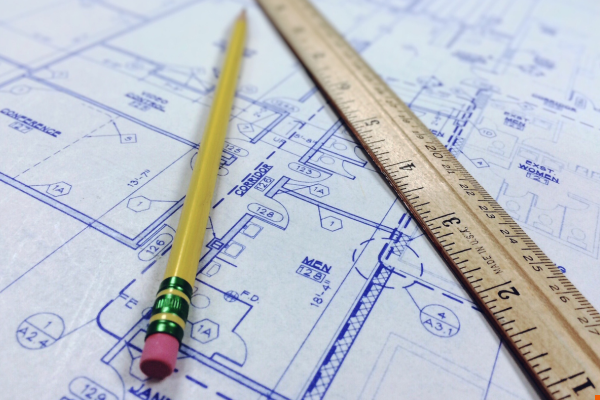
Design Professional’s Role in Minimizing Claims
Design professionals can play an important role in properly setting the course for the construction project, especially in minimizing the likelihood of claims and disputes. For example, not only can the architect serve as the master builder, but also as the master of dispute prevention and resolution.
There are four phases in a project where the design professional can make a difference in avoiding disputes or sowing the seeds of problems: (1) ensuring the adequate performance of pre-design services; (2) properly managing and coordinating the design phase services; (3) providing adequate and correct details in the design documents to allow construction; and (4) assisting in the management of construction phase services on behalf of the owner.
Pre-Design
The pre-design state (i.e., before the designer commences performance of the traditional role of preparing plans and specifications) is often the breeding ground for costly claims that arise during construction. Frequently, problems originate with: (a) an erroneous expectation or assumption by the owner that the designer will perform crucial services that must precede design, such as programming and site investigations; and (b) the designer’s failure to dispel the owner’s notion that the designer or indeed anyone is performing these vital services.
If a facility is designed without careful consideration of the needs of the end users, redesign may be required. This may complicate the pre-construction phases or prompt costly last minute changes during construction. Programming is the term commonly used to describe the analysis of the facility users’ needs, that is performed to delineate objectives, space requirements and relationships, site requirements, equipment, and budget.
An unsophisticated owner may attempt to minimize the programming effort, fail to recognize the need for programming, or attempt to perform the programming function with inadequate or untrained personnel. In either event, the designer is faced with a difficult choice – perform the programming for free, walk away from the project, or begin the design development without an adequate program.
Design without adequate programming may only serve to drive up the ultimate cost of both design and construction. When the owner realizes that some portion of the design will not meet its needs, the owner may require the designer to redesign various aspects of the work. If the matter is recognized during the schematic design phase, the revisions may be relatively inexpensive. However, the later the revisions are made, the more difficult, time-consuming and costly the redesign will be. For example, if revisions are made during the construction documents phase, when the details of the design are complete, many of the details may have to be changed. If the revisions are made during the punch list phase of construction, tear-out and rework may be required.
Equally serious problems may arise from not adequately performing certain investigations that should properly be performed prior to commencement of design. Three key investigations are: geotechnical and site studies; hazardous material abatement studies; and evaluation of existing building conditions and dimensions.
Unless these investigations are done properly and thoroughly, and the results effectively communicated to and utilized by the designer, the results frequently are a dispute over the designer’s entitlement to additional compensation and claims by construction contractors for differing site conditions.
Under the provisions of commonly used forms of design contracts, these investigations are to be performed by the owner and provided to the designer. These tasks are not part of the architect’s scope of work, but may be additional services. However, like programming, unless these investigations are done, and done properly, the designer is likely to be drawn into any dispute.
Quality Design Phase Services
Many construction claims have their origin in the quality control aspects of the design process. Design professionals can implement Total Quality Management concepts to provide coordination of design disciplines, as well as to provide adequate reviews to identify problem areas before proceeding with the next phase of the design process.
Almost every construction project requires that the work product of several design disciplines be incorporated into one comprehensive, coordinated design. These specialties include architectural, structural, mechanical, electrical, geotechnical and other types of engineers. If these different aspects are not coordinated, the result may be gaps, overlap and conflicts of the contract drawings and specifications that may not be identified until construction is underway.
It is also common for owners to engage specialty consultants (such as interior designers) who may have direct input into design. Coordination with the owner’s consultants may create problems such as the responsibility for integration and checking to avoid interferences, changes, and conflicts.
Design professionals may go the extra mile and take the opportunity to “inspect out” problems before the design is finalized. Even where quality control measures are built into the design process, design reviews may identify potential problems. While the emphasis of quality assurance should not be on inspection, performing periodic, thorough reviews of design documents during the various pre-construction phases may help minimize errors, omissions, ambiguities and conflicts in the contract documents.
Details in Contract Documents
Providing ample details in construction contract drawings and specifications often serves to minimize contractor claims during construction for increased costs and delays.
Insufficient details in contract documents may lead to numerous Requests for Information (RFI’s) and/or requests for changes from construction contractors. Contractors may also claim costs for delay and disruption while awaiting clarification on how to proceed. It is not unusual for contractor claims to cite the number of RFI’s on a project as justification for lost productivity and/or delays, and to allege that poor design performance is the culprit. Regardless of the merits of such allegations, they often drive a wedge between the owner and designer.
Some designers defer detailed engineering until shop drawing time, anticipating that the contractor ultimately will correctly supply the specifics. Given this latitude, some contractors will submit the cheapest rather than the best detail or product. The designer may have to expend even more time adding details and arguing with contractors during shop drawing review, or worse during installation of the system.
Designers may use performance specifications to pass along some of the detailed engineering responsibility to the contractor. Although there is an appropriate place for performance specifications, some contractors resist the additional engineering responsibility required.
Performance specifications are legitimately used to specify manufactured or standardized systems that more than one manufacturer can supply, but whose designs differ. By using a performance specification that describes functions, standards and performance results, more competitive bidding may result than from a detailed proprietary system. Indeed, any manufactured or fabricated product requires a certain amount of engineering to be performed. Contractors and their vendors often know the details better than the project designer, and are sometimes better equipped to provide engineering support.
Construction Phase Services
The designer is often called upon to be the pace setter, key actor, and critical player throughout both design and construction. The avalanche of delay-related litigation may fall back upon architects and engineers, as contractors often blame the designers’ performance for the causes of construction delays. Owners caught in the bind of paying contractors for delay claims, may in turn look to designers for contribution or indemnification.
Delay is most often recognized during the construction phase. However, delays in the design phase may serve to reduce the time allotted for construction, making the construction phase more susceptible to delay. For example, an owner may require a project occupancy date to be in thirty months from the time the designer is retained. If the design phase is established to be fifteen months, the remaining fifteen months are allotted for bidding and construction. If the design phase is extended to eighteen months and the owner insists on the original occupancy date, then the bidding and construction phase will be reduced. When an aggressive construction period is mandated, the likelihood of delay-related disputes is increased.
More importantly, tardy designer performance during the construction phase may lead to project delays and claims. The designer’s contract administration responsibilities often are tied to the timely performance of the field work. This may include responses to requests for information, shop drawing reviews, payment review, and change order processing. Belated performance of these responsibilities may lead to allegations against the designer.
Given the realities and complications of the design and construction process, disruptions and delays to the designer’s performance are often caused by or intertwined with delays due to owner interference, changes, involvement by the public or regulatory bodies, contractors, subcontractors, suppliers, acts of God, and third parties. The designer may have justifiable reasons for the perceived lack of timely performance.



0 Comments